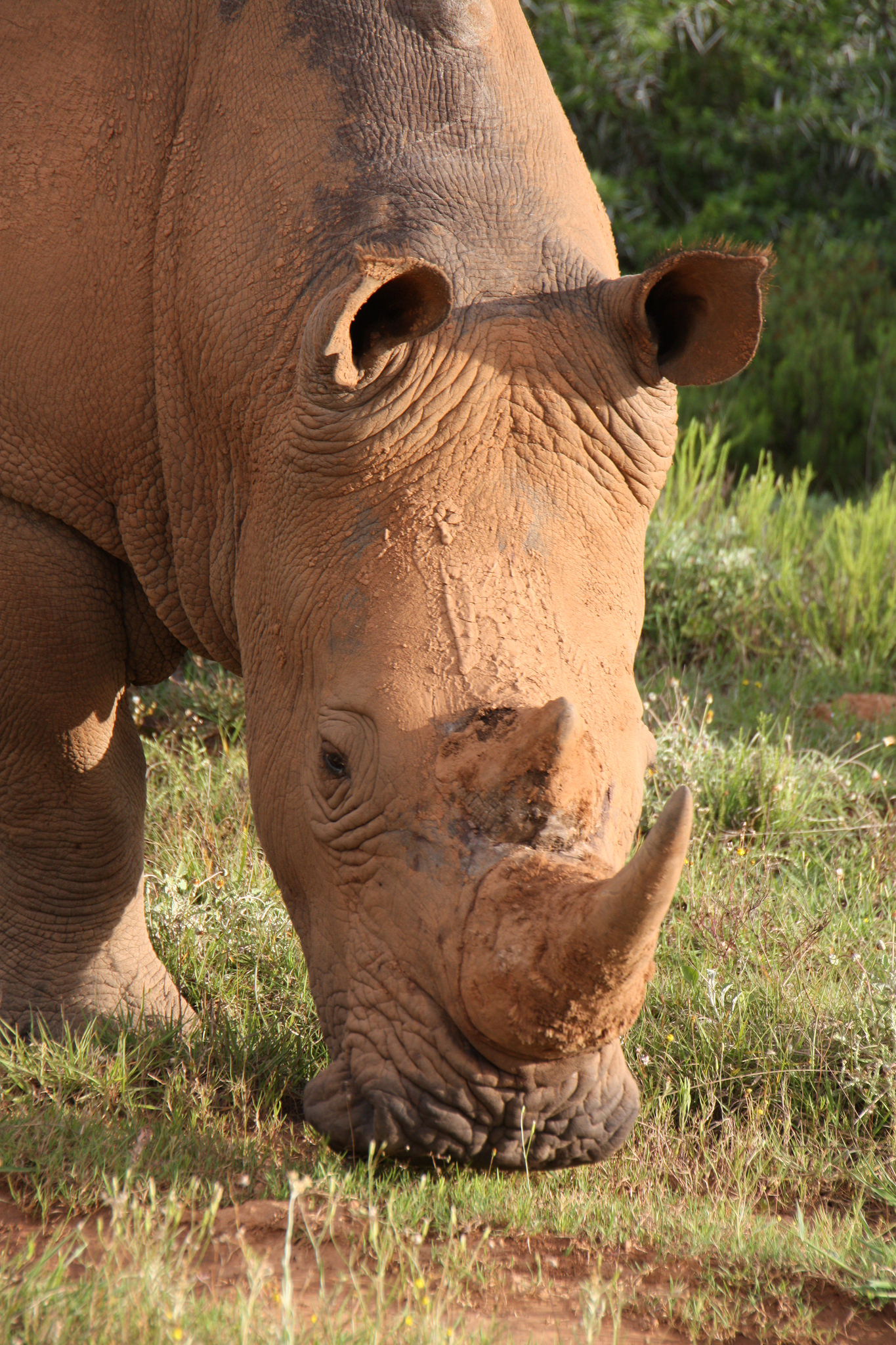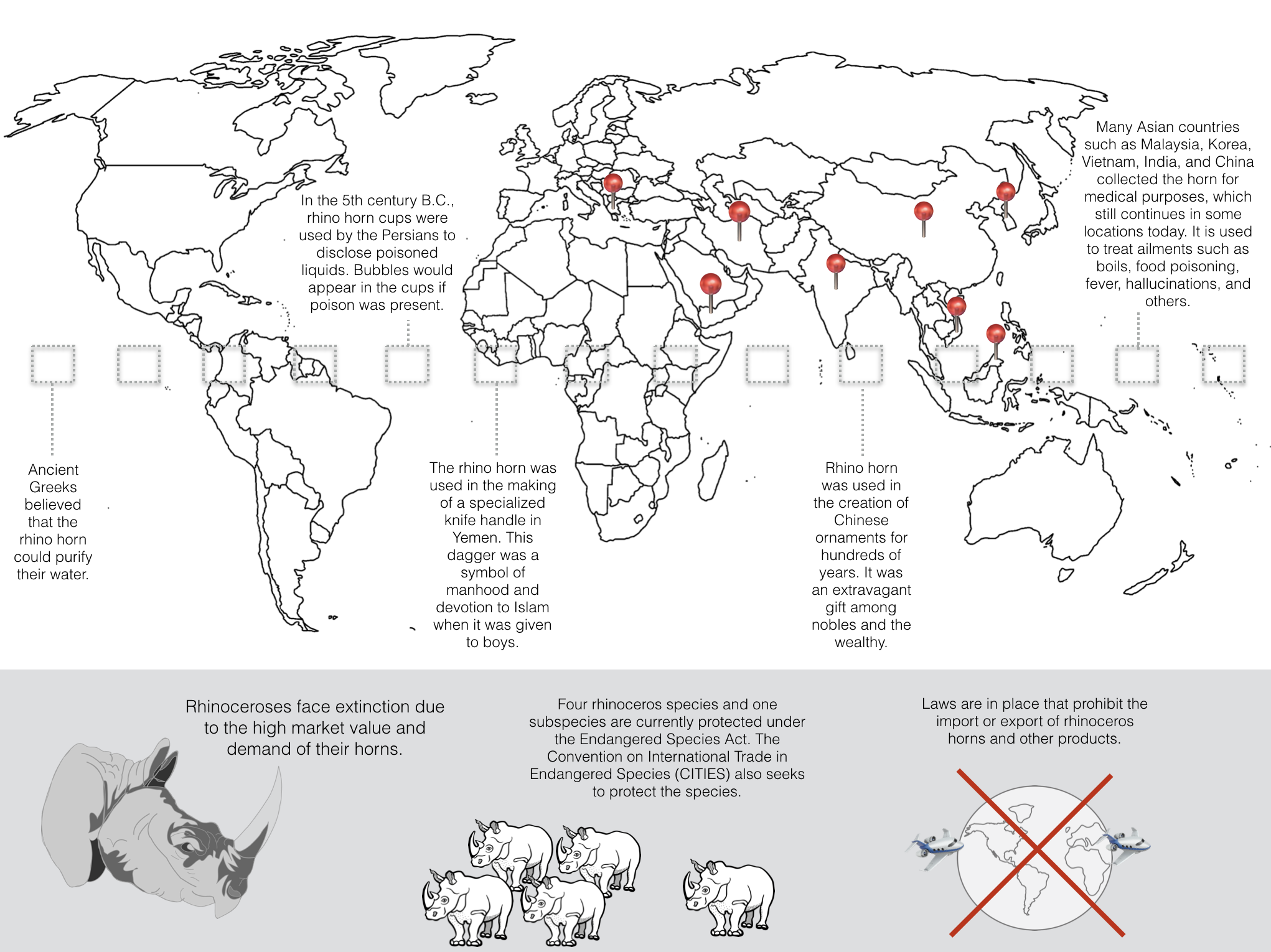Human-Wildlife Conflict
2.1 Legalizing Horn Trade as a Possible Solution to Reduce Poaching of the South African Rhinoceros
Jason Cochran
The long-term sustainability of South African rhinoceroses is in jeopardy due to exponential increases in poaching. In an effort to reduce poaching, many approaches have been tried with varying degrees of success. Could legalizing trade of rhinoceros horns reduce poaching in South Africa and foster greater awareness for the species?

Rhinoceros poaching in South Africa has significantly increased over the last 15 years and this poses a significant threat to the species.1 Specifically the number of rhinoceroses poached has increased exponentially, from 13 in 2007, to 668 in 2012.5,13 If this trend continues, it is predicted that existing rhino populations in Africa may no longer exist within the next two decades.6,11 While poaching is a threat to both the white rhinoceros (Ceratotherium simum) and the black rhinoceros (Diceros bicornis), the black rhinoceros is at greatest risk as the species is currently listed on the critically endangered list. It is estimated that approximately 5000 were remaining in the wild as of 2010.1,5,13
The majority of poached rhinoceroses are killed for their horns and the profit made through the illegal horn trade. It is estimated that rhinoceros horn can sell for approximately $60,000/kg ($27,215.57/lb) on the black market (exact figures vary by country), making it more valuable than gold by weight.1,7 This value inherently drives the market and perpetuates the cycle of rhinoceros poaching and illegal horn trade.1 Beyond the killing of an animal, the act of rhinoceros dehorning is a gruesome and brutal process. The animal is first sedated, immobilized, or shot and then the horn(s) are cut-off, typically using power tools, such as a chainsaw.16 Once the poachers have removed the horns, if not already dead, the rhinoceroses are often left to bleed to death.16 If found quickly, the animals can sometimes be treated and saved, though this is uncommon.16
In an effort to reduce rhinoceros poaching, many approaches have been tried with varying degrees of success. Proactive dehorning is one such approach, in which veterinarians and wildlife officials safely remove the majority of a rhinoceros’s horn or horns to make it a less attractive target for poachers.1,7 The rhinoceros is nursed back to health in a controlled way, with minimal health risks.1 Another approach that has been used on a small scale is the act of infusing chemicals, such as indelible dye, into rhinoceros horns.7,8 The assumptions made with this approach are that the horns will be undesirable due to discoloration and therefore will not be used for ornamental purposes, and/or that the chemically modified horn will be more unsafe for end-users or poachers.8 Although there may be minimal health risks to the rhinoceros, the act of infusing chemicals into rhino horns has many opponents who question the efficiency, ethics, and effectiveness of poisoning or dying rhinoceros horn in an effort to discourage poaching.8 Notably, results show that dyes injected into rhino horns may not be uniformly distributed throughout the horn which further undermines whether the process is truly effective at all.8
The black market for rhinoceros horn consists predominantly of Asian countries, specifically south east Asian countries such as China and Vietnam.9 Vietnam was the primary destination for rhinoceros horns confiscated from 2009 to 2014.12 In these countries it is considered a status symbol to possess rhinoceros horns or to use the horns in medical remedies.9 When used medicinally, the horn is often ground into a powder and then added to boiling water before being ingested.14 Historically, rhinoceros horn has been used in Chinese medicine for illnesses such as fever, headaches, food poisoning, gout, and hallucinations, though there is little scientific evidence of the horn’s medicinal benefits.14,17 Beyond its medicinal uses, in some countries the horn has cultural significance.14 In Yemen, rhinoceros horn is used to make handles for daggers, called “jambiya”, which are traditionally given to Yemeni boys at age 12.14,17,18

(lower left) Boy in Yemen with rhino horn jambiya dagger. Courtesy of Rod Waddington, 2014, FlickrCommons. CC BY-SA 2.0. (lower right) Chinese rhino horn cup. Courtesy of Daderot, 2015, Wikimedia Commons. Public Domain.
While buying and selling of rhinoceros horn continues in many countries, all trade of rhinoceros horn is currently illegal under the Convention on the International Trade in Endangered Species (CITES).1,10 This trade ban has been in place since 1977.1,4 Some believe this ban only limits supply which increases the value of the horn, and subsequently, these higher prices reinforce the view that possessing rhinoceros horn is a sign of status and wealth.1 Neither the CITES ban nor country-specific poaching penalties have been successful in curtailing poaching as the practice continues to increase.3,17 The penalties that are imposed on poachers vary significantly by country, from years in prison to monetary fines.6 CITES does not have an effective ability to legislate enforcement in countries where this ban is violated, and an unenforceable mandate is ineffective.17 Because of the shortcomings of the current management approach, some have proposed legalizing the horn trade may be the best way to ultimately reduce poaching and protect the long-term sustainability of wild rhinoceros populations.1,6
Proponents of horn trade legalization argue that by controlling the supply of horns, poaching would become unnecessary.1,6,11 Individuals looking to obtain rhinoceros horn would have a legal and cheaper means to purchase the product and the demand for poaching would therefore decrease.1,6 By regulating and legalizing the process, the sales could also be taxed, and some funds could be reinvested into conservation efforts.6,11 Under this system of legal trade, rhinoceros horn could be harvested from natural deaths, and in a controlled and safe way from living rhinoceroses.1 Proponents also cite the success of other similar trade legalizations to reduce poaching, such as the trade of crocodile skin.1 The results of one cost-benefit analysis projected that profit as large as $717,000,000/year could be made if legalization occurred, and those funds could be invested into conservation efforts.6 This same analysis also predicts that under the current management approach, the white rhinoceros will become extinct in less than 20 years.6 In another analysis, five different strategies were analyzed for cost-benefit and the findings indicated that the benefits outweighed the costs for strategies which in some way, provided a legal rhinoceros horn supply.6,9

Opponents of horn trade legalization have a less optimistic view of a legalized rhinoceros horn market.2,4,15 They argue that some analyses may be oversimplified as the cost of rhinoceros horn in a regulated and legalized market is unknown.4,15 Additionally, it is possible that in a legalized market the demand may increase as the stigma associated with illegal-trade is removed.2,15 There is also the risk of reawakening markets in countries where progress has been made to reduce the demand for rhinoceros horn, such as Japan and Taiwan.9 It may also be considered unethical to legalize trade of rhinoceros horn and there is concern about condoning behavior (selling rhinoceros horn) which has been banned for over 35 years.6 In another analysis, which modeled the horn market based on different management approaches, the results indicated that alternative methods to trade-legalization, such as increased consumer education, would be more effective.4,15 Generally, opponents of trade-legalization favor increased awareness and education about the state of rhinoceros populations and more stringent fines and penalties for poachers.15 Additionally, sanctions and fines against countries unable to curtail the import and/or export of the illegal product may be effective in reducing poaching.6
The debate of how to best protect wild rhinoceros populations is complex. Ethical, cultural, and financial decision-making all influence how individuals view the trade of rhinoceros horn. The apparent inadequacies of the current approach, as is evident by the increasing occurrence of poaching, have fueled the conversation around whether legalization of horn trade would ultimately help or hurt conservation efforts. While proponents for legalization of rhinoceros horn trade make a compelling argument for control through the supply-and-demand model, opponents argue that there is insufficient understanding of how the market would react to legalization.2,6 The results from the various studies are inconclusive and a consensus has not been reached due to various unknowns, such as the price of rhinoceros horn in a legalized market. Research into this topic indicates that both proponents and opponents of rhinoceros horn trade legalization agree that the current policies and practices are inadequate and change is needed. The future of the South African rhinoceros may depend on the ability to compromise in this complex debate.

References:
- Biggs, D., et al. (2013). Legal Trade of Africa’s Rhino Horns. Science, 339(6123):1038-1039.
- Collins, A., et al. (2013). Rhino Poaching: Supply and Demand Uncertain. Science, 340(6137): 1167.
- Convention on International Trade of Endangered Species of Wild Fauna and Flora. (2012, July 31). CITES acts to curb smuggling of elephant ivory and rhino horn. Retrieved from: https://www.cites.org/eng/news/pr/2012/20120731_SC62_results.php
- Crookes, D.J., & Blignaut, J.N. (2015). Debunking the Myth That a Legal Trade Will Solve The Rhino Horn Crisis: A System Dynamics Model for Market Demand. Journal for Nature Conservation, 28:11-18.
- Department of Environmental Affairs, South Africa. (2017). Rhino poaching statistics update.
- Di Minin, E., et al. (2015). Identification of policies for a sustainable legal trade in rhinoceros horn based on population projection and socioeconomic models. Conservation Biology, 29(2): 545-555.
- Earth Touch News Network. (2014, September 16). Top 10: Shocking figures of the illegal horn trade Retrieved from http://www.earthtouchnews.com/environmental-crime/illegal-trade/top-10-shocking-figures-of-the-illegal-rhino-horn-trade
- Ferreira, S.M., et al. (2014). Chemical horn infusions: a poaching deterrent or an unnecessary deception? Pachyderm, 55:54-61.
- Ferreira, S.M., et al. (2014). Management strategies to curb rhino poaching: alternative options using a cost–benefit approach. South African Journal of Science, 110(5-6):1-8.
- International Fund for Animal Welfare. (2013, November). Horn of contention: a review of literature on the economics of trade in rhino horn.
- Martin, R. (2012). A Legal Trade in Rhino Horn: Hobson’s Choice (Rhino Survival Trust, Johannesburg, South Africa.
- Miliken, T., (2014). Illegal Trade in Ivory and Rhino Horn: An assessment to improve law enforcement under the wildlife TRAPS project. USAID and TRAFFIC.
Mketeni, F. (2012, January 25). South Africa Department of Environmental Affairs: Rhino Poaching—Government interventions presentation, Public Hearing. Retrieved from https://pmg.org.za/committee-meeting/13886/ - PBS:Nature. (2010, August 20). Rhino Horn Use: Fact vs. Fiction. Retrieved from http://www.pbs.org/wnet/nature/rhinoceros-rhino-horn-use-fact-vs-fiction/1178/
- Prins, HHT., & Okita-Ouma, B. (2013). Rhino poaching: unique challenges. Science, 340(6137): 1167-1168.
- Rhino Conservation Botswana. The Poaching Crisis.
- Still, J. (2003). Use of animal products in traditional Chinese medicine: environmental impact and health hazards. Complementary therapies in medicine, 11(2):118-122.
- Vigne, L., & Martin, E. (2013). Increasing rhino awareness in Yemen and a decline in the rhino horn trade. Pachyderm, 53:51-58.
Figures:
- Clker-Free-Vector-Images. (2014). [Graphic: rhino head clip art image]. Retrieved from Pixabay. Public Domain.
- Daderot. (2015). [Photograph of rhino horn cup in China Museum]. Modified from Wikimedia Commons. Public Domain.
- Elliot, Steve. (2012). [Photograph of Rhinoceros: cover image]. Retrieved from FlickrCommons. CC BY-SA 2.0.
- Gilkeson, Joanna. United States Fish and Wildlife Service. (2016). [Photograph of confiscated rhino horn]. Retrieved from FlickrCommons. CC BY 2.0.
- KronosLine. (2014). [Graphic: world outline]. Retrieved from Wikimedia Commons. CC BY-SA 3.0
- Open Clipart-Vectors. (2017). [Graphic: full rhino clip art image]. Retrieved from Pixabay. Public Domain.
- Ted. (2010). [Photograph of three Southern White Rhinos]. Retrieved from FlickrCommons. CC BY-SA 2.0.
- U.S. Fish and Wildlife Service. Facts about Rhino Horn. [Data for graphic].
- Waddington, Rod. (2014) [Photograph of boy with Jambiya in Khat, Yemen]. Retrieved from FlickrCommons. CC BY-SA 2.0.
